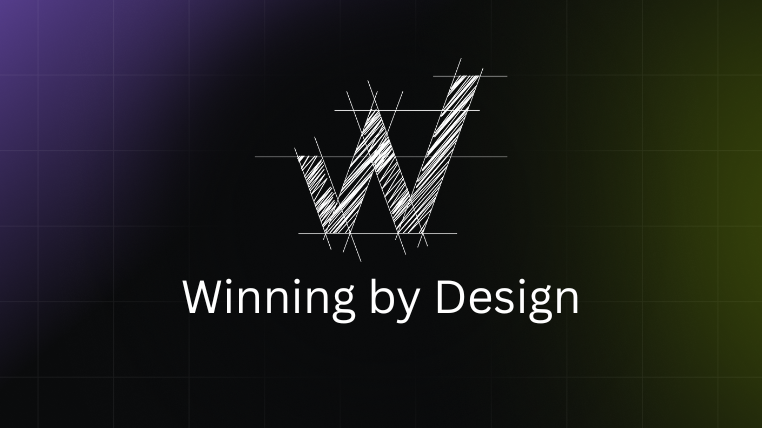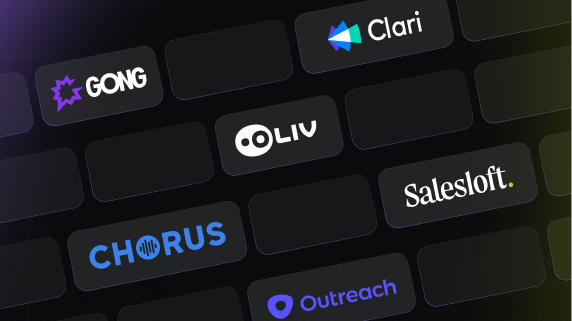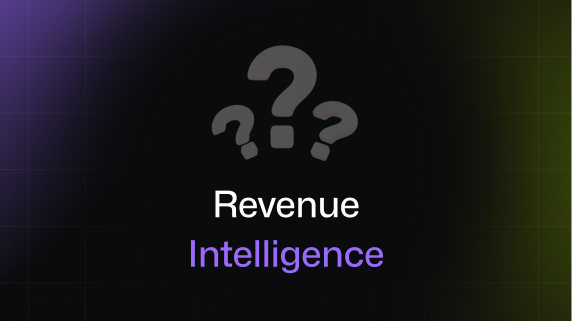Q1. What is Gong Forecasting and How Does It Work? [toc=What is Gong Forecasting]
Sales forecasting remains one of the most time-consuming rituals in B2B sales organizations. Every Thursday and Friday, sales managers spend 6+ hours manually reviewing pipelines with their reps, compiling spreadsheet forecasts, and preparing presentations for Monday's VP call. This administrative burden persists despite significant investments in revenue intelligence platforms—a reality that prompted companies to adopt Gong Forecast, which promised AI analyzing 300+ buying signals from customer conversations to predict deal outcomes.
⚙️ How Gong's Forecasting Approach Works
Gong Forecast operates through activity-based signal tracking across calls, emails, meetings, and CRM data. The platform captures 300+ buying signals including competitor mentions, pricing discussions, legal review stages, and sentiment shifts during conversations. These signals feed into forecast boards organized by categories:
- ✅ Commit: High-confidence deals expected to close this period
- 📊 Best Case: Opportunities with moderate likelihood requiring active management
- 📈 Pipeline: Early-stage deals with uncertain timelines
Deal likelihood scoring methodology assigns probability percentages based on conversation frequency, stakeholder engagement, and progression velocity. Gong integrates with Salesforce, HubSpot, and Microsoft Dynamics to sync forecast categories, though managers must manually update these fields as deals evolve.
However, Gong's forecasting receives a 4/10 market rating—significantly weaker than its conversation intelligence capabilities (rated 8/10). User Scott T., Director of Sales, notes:
"The additional products like forecast or engage come at an additional cost. Would be great to see these tools rolled into the core offering."
— Scott T., Director of Sales G2 Verified Review
❌ The Pre-Generative AI Limitation
Built in the previous decade, Gong relies on keyword matching and activity tracking that cannot understand conversational context or buyer intent. When a prospect says "budget freeze," "spending authority delayed," or "board approval needed"—all indicating the same risk—Gong's keyword-based system treats these as separate unrelated signals. Processing delays of 5-10 minutes prevent real-time intervention when deals shift direction mid-call.
Trafford J., Senior Director of Revenue Enablement, highlights the operational burden:
"It can be overwhelming to set up trackers. AI training is laborious to get it to do what you want."
— Trafford J., Senior Director of Revenue Enablement G2 Verified Review
✨ How Modern AI Transforms Forecasting
Generative AI-native platforms understand context rather than just tracking keywords. Real-time predictive analytics update continuously as new information arrives—not just during periodic dashboard reviews. Autonomous execution eliminates human interpretation requirements, with AI prescribing specific next actions instead of generic risk flags.
Comprehensive data capture across all revenue signals (calls + emails + CRM + social intelligence) provides holistic deal health visibility without blind spots. This contrasts sharply with traditional revenue intelligence platforms that fragment insights across disconnected systems.
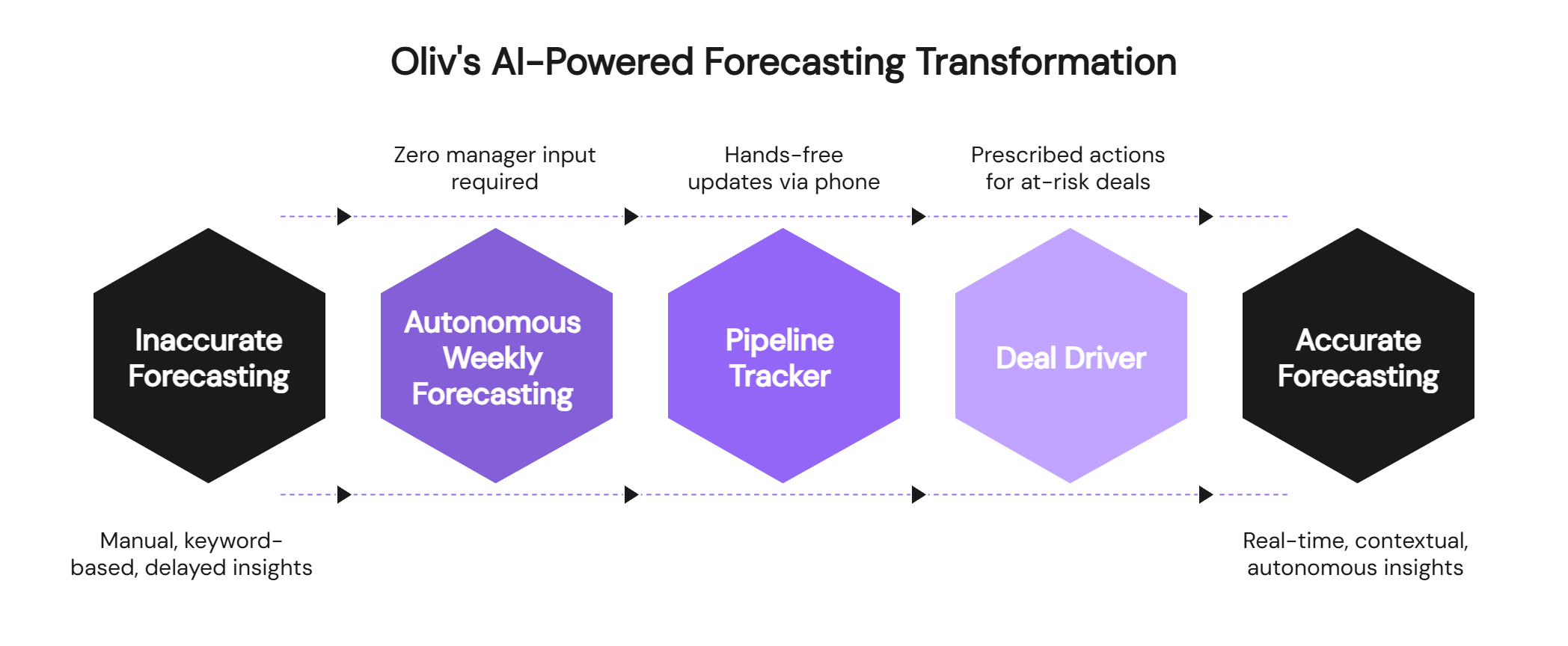
🤖 Oliv.ai's Forecaster Agent: The Agentic Alternative
We've designed our Forecaster Agent to perform autonomous weekly forecasting with zero manager input. The agent analyzes every pipeline deal, generating bottom-up roll-ups with AI commentary explaining predictions: "Deal likely to slip—last 3 calls showed budget concerns + champion hasn't responded to emails in 8 days."
Our Pipeline Tracker calls reps nightly for hands-free updates via phone, syncing instantly to CRM and eliminating manual data entry. Deal Driver flags at-risk opportunities with prescribed actions like "Schedule technical deep-dive with IT team by Thursday to address security concerns"—not just generic red flags requiring manager interpretation.
Managers receive presentation-ready one-page reports eliminating the 6-hour Friday forecasting prep, converting manual compilation into 15-minute Monday morning reviews. This represents a fundamental shift from traditional SaaS tools requiring manual adoption to AI agents that work autonomously.
📊 The Efficiency Transformation
Teams consolidating from legacy manual systems to AI-native unified platforms report 25% higher forecast accuracy and 75% reduction in forecasting time compared to traditional Gong + Clari stacks. This shift transforms insights requiring interpretation into autonomous execution driving outcomes—allowing managers to redirect 4-5 hours weekly toward strategic coaching instead of administrative compilation.
Q2. How Accurate is Gong Forecasting in 2025? [toc=Gong Forecast Accuracy]
84% of US companies missed revenue forecasts in at least one quarter over the last two years—a forecasting accuracy crisis threatening strategic planning, resource allocation, and investor confidence. Traditional forecasting fails because CRM data remains incomplete (reps avoid manual updates), activity-based signals miss nuanced deal context, and managers lack real-time visibility into changing deal dynamics.
📈 Gong's Accuracy Claims vs. Reality
Gong markets 90-95% accuracy benchmarks citing customer case studies: Piano achieving 90% accuracy, SpotOn hitting 95%, and Upwork reaching 95% forecast precision. Gong's accuracy scale categorizes forecasts as:
- 🟢 Green (85-115%): High confidence predictions
- 🟡 Pink (70-84%): Medium risk requiring attention
- 🔴 Red (Below 70%): Low confidence needing immediate intervention
Gong claims 20% greater accuracy than CRM-based algorithms by analyzing 300+ buying signals from actual customer conversations rather than manually entered CRM fields.
⚠️ The Critical Limitation Nobody Mentions
Accuracy depends entirely on CRM data quality and manual forecast category updates by reps. If data is stale or incomplete, predictions fail regardless of AI sophistication. Neel P., Sales Operations Manager, exposes data portability challenges:
"Gong's support team has stated we ensure data is available in a 'readily usable format'... However, their current solution requires downloading calls individually, which is impractical and inefficient for large volume."
— Neel P., Sales Operations Manager G2 Verified Review
Karel Bos, Head of Sales, confirms forecasting underutilization:
"Gongs deal forecasting we don't use."
— Karel Bos, Head of Sales TrustRadius Verified Review
❌ Why Pre-Generative AI Platforms Struggle
Keyword-based tracking misses conversational variants—"budget freeze," "spending authority," and "board approval needed" all signal identical risk but use different language. Gong's 5-10 minute processing delays prevent real-time intervention when deals suddenly shift.
The platform cannot understand sentiment or intent shifts during calls. Excited prospects and politely disengaging buyers sound similar in transcripts, but generative AI detects these critical nuances. Conversation-centric blind spots limit email analysis, social intelligence integration, and holistic revenue views.
Understanding how Gong integrations work reveals further limitations: data sync delays and limited API coverage create gaps in real-time forecasting accuracy.
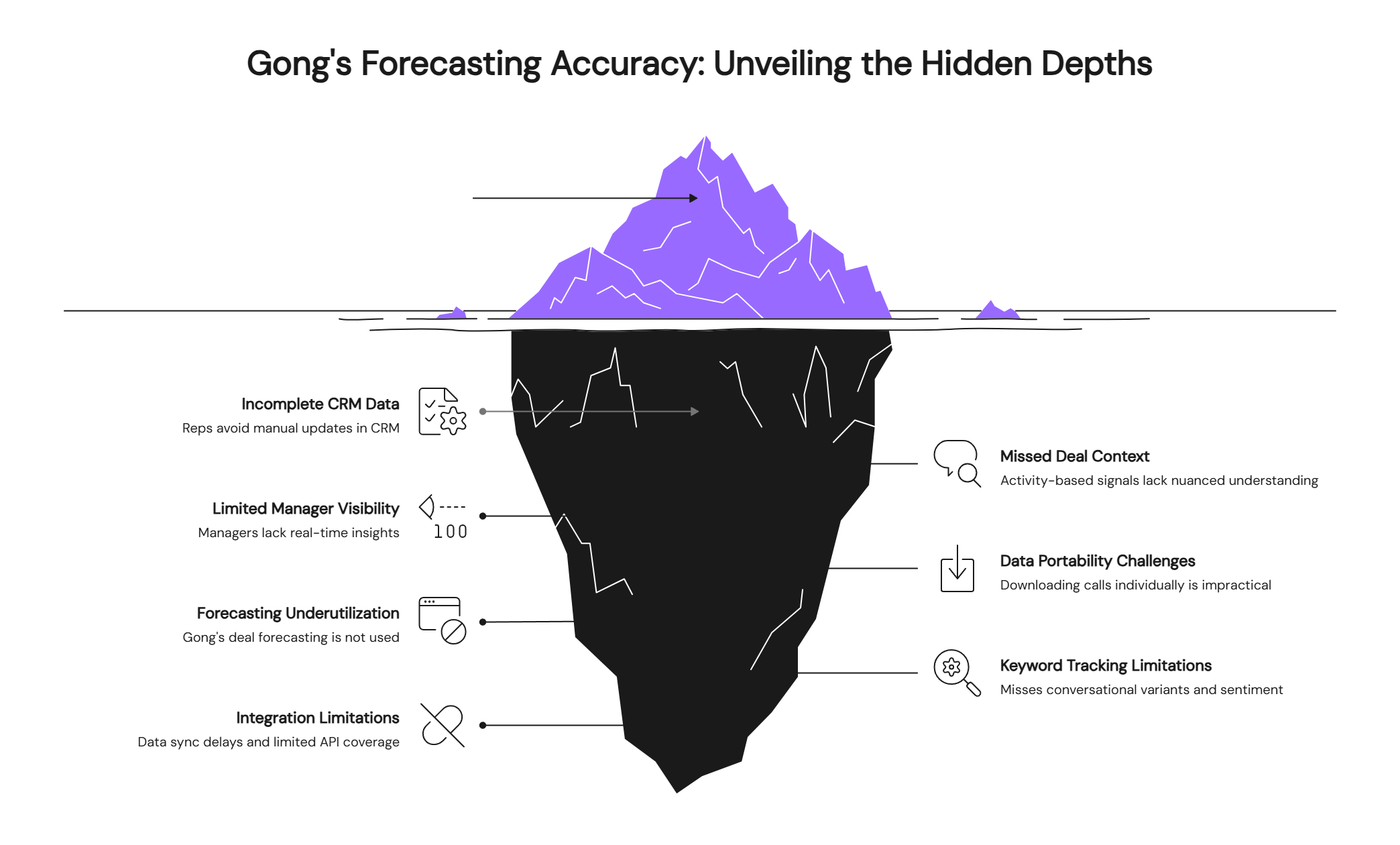
✅ Oliv.ai's Generative AI-Native Approach
Our Forecaster Agent captures nuanced deal signals automatically across all channels (calls + emails + CRM + meetings + social). Continuous real-time analysis updates insights constantly as new information arrives—not just during periodic manual reviews.
Predictive risk assessment provides specific intervention recommendations: "Schedule technical deep-dive with IT team by Thursday" rather than generic red/yellow/green flags requiring manager interpretation. AI commentary explains predictions with transparent reasoning: "Deal confidence dropped 22% because champion missed last two meetings and competitor Salesforce mentioned 3x in recent calls."
This transparent approach contrasts with the black-box calculations plaguing traditional revenue orchestration platforms where weighted forecasts remain unexplained mysteries.
💬 The Black-Box Problem
Traditional tools frustrate users with opaque calculations. Users consistently report: "I don't know where my weighted number comes from" as a common complaint about legacy forecasting systems.
We contrast this with transparent AI reasoning showing exactly why predictions changed and what signals influenced forecasts—building trust through explainability rather than demanding blind faith in black-box algorithms.
Q3. Why Does Gong Forecasting Still Require Manual Work? [toc=Manual Work Requirements]
The "Monday Forecasting Call" pain point defines B2B sales management. Sales managers spend Thursdays and Fridays—often 6+ hours—manually reviewing pipelines with each rep (1-2 hours per 5-person team), compiling consolidated forecasts by aggregating individual predictions in spreadsheets, and preparing presentation slides for VP review with deal-by-deal justifications. Despite investing in Gong, this manual burden persists.
⚠️ The Five Manual Dependencies Gong Can't Eliminate
1. Manual Forecast Category Updates: Reps must manually update Commit/Best Case/Pipeline categories in CRM after every deal change. Gong cannot auto-categorize because it lacks contextual understanding of deal readiness.
2. Dashboard Interpretation Burden: Managers manually review Gong dashboards to interpret deal health signals. Red flags appear but don't prescribe actions—the system says "high risk" but managers decide what to do.
3. No Automatic Roll-Up Functionality: Managers aggregate individual forecasts manually across teams. John S., Senior Account Executive, describes the friction:
"Understanding the pipeline management portion of it is almost impossible. Some people figure it out, but I think most just fumble through."
— John S., Senior Account Executive G2 Verified Review
4. Deal Risk Flag Interpretation: The platform identifies risks but requires human analysis to convert signals into action plans—perpetuating administrative overhead.
5. Constant Configuration Maintenance: Forecast boards need 8-12 hours monthly field mapping maintenance as sales messaging evolves. This burden extends across Gong's implementation timeline, creating ongoing operational costs.
❌ The Technological Root Cause
Pre-generative AI (built previous decade) uses simple keyword matching and activity tracking incapable of understanding conversational context or intent. Manual human review bridges the gap between raw data (call happened, keywords mentioned) and actionable insights (deal will close/slip).
Annabelle H., Board Director, captures the AI maturity gap:
"AI is not great (yet)—the product still feels like its at its infancy and needs to be developed further."
— Annabelle H., Board Director G2 Verified Review
This creates perpetual administrative overhead defeating automation promises. AI generates insights but humans must activate them—the exact workflow burden forecasting platforms should eliminate.
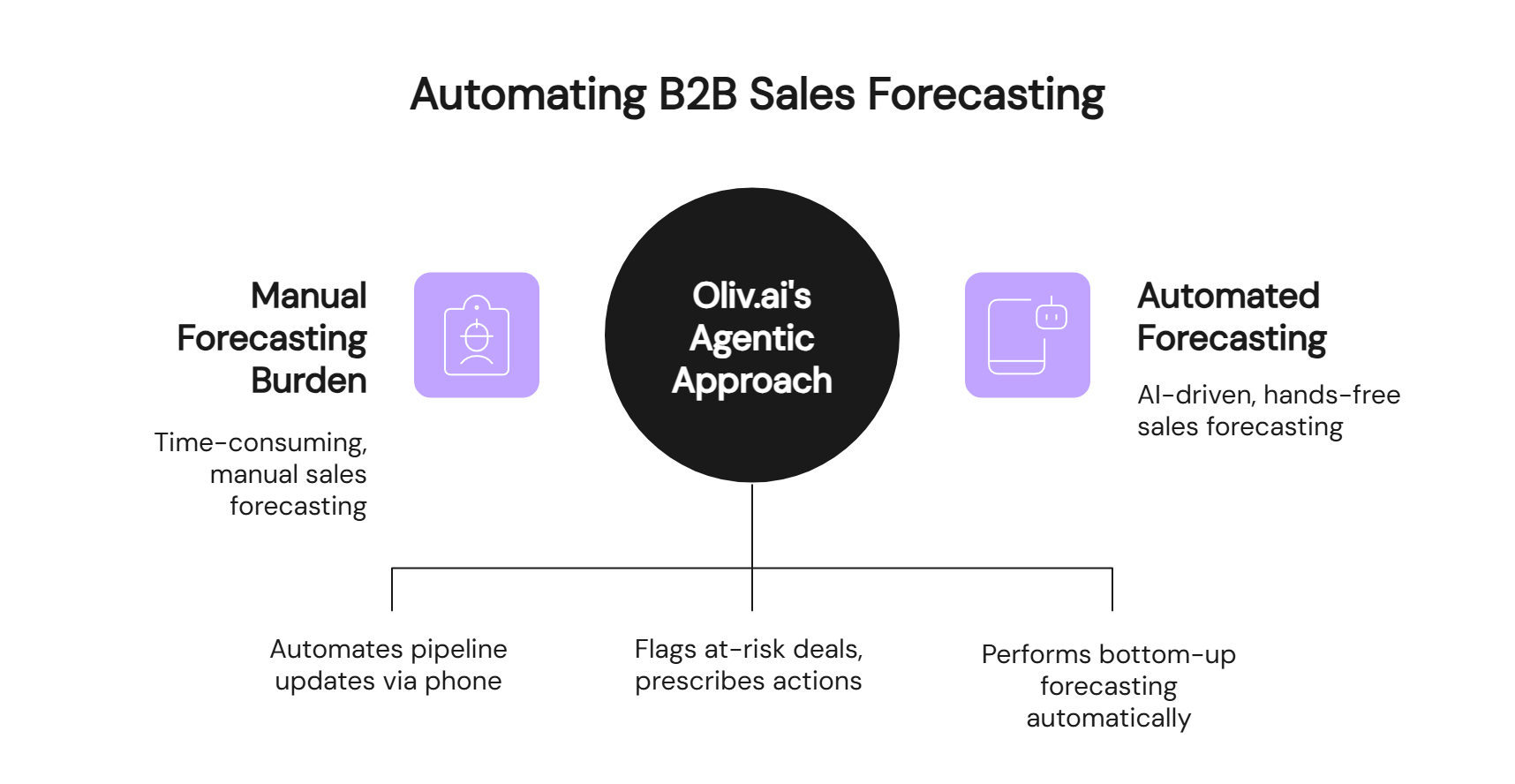
🤖 Oliv.ai's Agentic Approach
Our Forecaster Agent performs bottom-up forecasting automatically every week with zero manager input. Pipeline Tracker calls reps nightly for hands-free pipeline updates via phone (syncing instantly to CRM), eliminating manual data entry entirely.
Deal Driver flags at-risk deals with prescribed specific actions: "Schedule technical deep-dive with IT team by Thursday to address security concerns raised in 10/3 call." Managers receive presentation-ready one-page reports with AI commentary—eliminating 6-hour Friday forecasting prep and converting manual compilation into 15-minute reviews.
This autonomous approach represents the evolution from traditional revenue intelligence to orchestration, where AI agents execute work rather than just providing insights requiring human interpretation.
⏰ Quantified Efficiency Gains
Teams consolidating from legacy manual systems report 75% reduction in forecasting time (from 6 hours to 90 minutes weekly), allowing managers to redirect 4-5 hours toward strategic coaching instead of administrative compilation.
The shift from manual interpretation to autonomous execution represents the fundamental difference between pre-generative AI SaaS platforms and AI-native agentic solutions.
Q4. How to Set Up Gong Forecasting: Complete Implementation Guide [toc=Setup & Implementation]
Implementing Gong Forecast requires systematic configuration across CRM integration, forecast board setup, field mapping, and team enablement. Organizations should expect 8-24 weeks implementation timelines depending on team size, with enterprise deployments (100+ users) often requiring 6+ months.
Phase 1: CRM Integration Requirements (Weeks 1-3)
Salesforce Configuration: Connect Gong to Salesforce by granting API access through Connected Apps. Map standard objects (Opportunities, Accounts, Contacts, Leads) and configure bidirectional sync for forecast categories. Salesforce edition must support API calls—Professional edition requires purchasing API access add-on.
HubSpot Integration: Install Gong's HubSpot app through the marketplace. Configure deal stage mapping, company association rules, and contact synchronization. Note: HubSpot's custom object limitations may restrict complex forecast hierarchies.
Microsoft Dynamics 365: Enable Gong-Dynamics connector through Azure Active Directory authentication. Configure entity mappings for opportunities, accounts, and activity logs. Multi-currency setup requires additional configuration (see Phase 3).
Data Prerequisites Checklist:
- ✅ Clean CRM opportunity data (complete close dates, amounts, stages)
- ✅ Standardized forecast categories across teams
- ✅ User license assignments in CRM matching Gong seats
- ✅ API rate limits confirmed (Salesforce: 15K calls/24hrs minimum)
Understanding comprehensive Gong pricing helps teams budget for the necessary CRM licenses and API capacity beyond base platform costs.
Phase 2: Forecast Board Configuration (Weeks 4-6)
Navigate to Forecast Settings in Gong admin console. Create forecast hierarchies matching sales org structure (Region → Team → Individual Rep). Configure forecast categories:
- Commit: Deals 90%+ likely to close this period
- Best Case: Opportunities 60-89% probability
- Pipeline: Early-stage deals <60% confidence
Set roll-up rules defining how individual forecasts aggregate to team/regional levels. Configure custom fields (maximum 25) for tracking methodology-specific data (MEDDIC scores, champion engagement, technical validation status).
Phase 3: Multi-Currency and Global Team Setup (Weeks 7-8)
Enable multi-currency forecasting through Settings → Currencies. Select corporate currency for consolidated reporting. Note: Gong uses CRM conversion rates—ensure Salesforce/HubSpot dated exchange rates are current.
Known Limitation: Multi-currency forecast roll-ups sometimes display inconsistently. Users report: "Multiple currency issue with Gong Forecast—trying to help find workarounds."
Configure territory hierarchies for cross-regional coordination, accounting for time zone differences in forecast submission deadlines.
Phase 4: API Limitations and Sync Timing (Week 8+)
Understand sync constraints:
- 5-10 minute poll intervals for CRM data updates (not real-time)
- 8 webhook event types available for automation (vs. 20+ in modern platforms)
- 25 custom CRM field maximum for synchronization
Implementation Timeline Expectations:
- Small teams (10-25 users): 8-12 weeks
- Mid-market (50-100 users): 12-16 weeks
- Enterprise (100+ users): 16-24 weeks
Detailed Gong implementation timeline analysis reveals why enterprise deployments consistently exceed 6 months, creating delayed ROI and frustrated stakeholders.
💰 Hidden Costs to Budget
Professional services fees: $15K-30K for complex implementations. Third-party vendor fees: $10K+ for specialized configuration partners. Ongoing maintenance: 8-12 hours monthly for tracker tuning as messaging evolves.
Comparing Gong alternatives reveals significant cost and timeline advantages with newer AI-native platforms requiring minimal setup overhead.
How Oliv.ai Simplifies Setup
We eliminate lengthy implementations through 1-2 week deployments. Our AI agents require minimal configuration—generative AI understands context automatically without manual tracker setup. Zero third-party vendor fees or professional services requirements. Self-service setup with guided workflows replaces months-long enterprise implementations, delivering ROI immediately rather than after 6-month waiting periods.
Q5. What Does Gong Forecasting Cost? (Hidden Fees Exposed) [toc=Pricing & Hidden Costs]
Gong's pricing model delivered sticker shock when it jumped from $160/user/month baseline to $250/user/month bundled pricing (Forecast + Engage)—a 56% price increase. For a 50-rep sales team, this translates to $150K annually before hidden costs surface. Traditional enterprise sales tech stacks compound expenses: companies frequently spend $300-500K annually across Gong + Clari + engagement platforms, forcing CFOs to justify bloated budgets amid intensifying ROI scrutiny.
Scott T., Director of Sales, exposes the bundling frustration:
"The additional products like forecast or engage come at an additional cost. Would be great to see these tools rolled into the core offering."
— Scott T., Director of Sales G2 Verified Review
💸 Hidden Implementation Costs Nobody Warns You About
Beyond software licensing, Gong implementations drain budgets through multiple hidden cost centers that vendors downplay during sales conversations:
Professional Services Fees: $15K-30K for complex multi-CRM setups. Gong pushes third-party implementation partners specializing in configuration—adding $10K+ for RevOps consulting, custom field mapping, and best practices workshops.
Implementation Timeline Costs: 8-24 weeks consuming internal resources. Larger teams face 6+ month deployments requiring dedicated project managers, technical architects, and executive sponsorship. Enterprise implementations (100+ users) demand 200-500 hours of internal team time.
Ongoing Maintenance Burden: 8-12 hours monthly tracker maintenance as sales messaging evolves. Trafford J., Senior Director of Revenue Enablement, confirms:
"It can be overwhelming to set up trackers. AI training is laborious to get it to do what you want."
— Trafford J., Senior Director of Revenue Enablement G2 Verified Review
Opportunity Cost: Delayed ROI during lengthy implementations—teams pay licensing fees for 3-6 months before achieving full adoption and value realization. Detailed analysis of Gong implementation timelines reveals why enterprise deployments consistently exceed expectations.
⚠️ The Dual-Tool Trap: When $250 Becomes $500
Gong forecasting's 4/10 market rating forces companies to add Clari ($200+/user/month) for robust forecasting capabilities Gong can't deliver alone. Combined stack costs ~$500/user/month ($300K annually for 50-rep team). This dual-license model:
- Doubles total cost of ownership while creating 30-40% feature redundancy
- Creates integration friction with 5-10 minute data sync delays
- Scatters data across platforms requiring manual consolidation
- Burdens reps with duplicate data entry updating both systems
Iris P., Head of Marketing/Sales/Partnerships, voices cost-consciousness frustration:
"It was a big mistake on our part to commit to a two year term... it's probably the highest end option on the market, and now we're stuck with a tool that works technically but isn't the right business decision."
— Iris P., Head of Marketing/Sales/Partnerships G2 Verified Review
Understanding comprehensive Gong pricing structures helps teams budget for the true total cost of ownership beyond initial quotes.
✅ Oliv.ai's Unified Economics
We designed our platform to eliminate the dual-tool trap entirely. Our single unified platform replaces both Gong + Clari at 60-70% cost reduction—saving $180-210K annually for 50-rep teams previously paying $300K for combined stacks.
Modular pricing allows teams to pay only for agents needed. Forecaster Agent in alpha tier delivers enterprise forecasting without forcing teams to purchase unused conversation intelligence or engagement modules. 1-2 week deployment replaces 6-month Gong implementations—ROI starts immediately rather than after half-year waiting periods.
Zero third-party vendor fees or professional services requirements. Self-service setup with guided workflows eliminates $15K-30K implementation costs. Generative AI adapts automatically—no ongoing 8-12 hour monthly tracker maintenance burden.
Comparing Gong alternatives reveals how AI-native platforms deliver superior economics through unified architecture and autonomous operation.
💰 ROI Transformation in First Quarter
Early adopters consolidating from Gong + Clari report 30% faster deal cycles, 25% higher forecast accuracy, and positive ROI within first quarter. For 50-rep teams spending $300K annually, switching to Oliv saves $180-210K while improving outcomes—paying for itself in 6-8 weeks.
Q6. Gong Forecast vs Clari: Why Teams Use Both (And Hate It) [toc=Gong vs Clari Comparison]
Market reality reveals a painful compromise: Gong excels at conversation intelligence (call recording, transcription, talk-time analytics) earning 8/10 ratings, but forecasting is weak (4/10 rating). Clari's USP centers on roll-up forecasting with management hierarchy visibility, but lacks conversation context and suffers from clunky UI. Result: Companies use Gong for CI and Clari for forecasting, paying ~$500/user/month combined (~$300K annually for 50-rep team).
Karel Bos, Head of Sales, confirms forecasting underutilization:
"Gongs deal forecasting we don't use."
— Karel Bos, Head of Sales TrustRadius Verified Review
❌ User Frustrations With Both Platforms
Gong's Manual Dependencies:
- Requires manual dashboard monitoring—no autonomous roll-ups or predictive categorization
- Reps must manually update forecast categories (Commit/Best Case/Pipeline) after every deal change
- Deal risk flags require human interpretation and action planning
John S., Senior Account Executive, captures complexity frustration:
"Understanding the pipeline management portion of it is almost impossible. Some people figure it out, but I think most just fumble through."
— John S., Senior Account Executive G2 Verified Review
Clari's Opacity Problems:
- Clunky UI with opaque calculations frustrating managers
- "I don't know where my weighted number comes from" remains common G2 complaint
- No conversation context—misses nuanced deal signals requiring manual investigation
Both Built on Pre-Generative AI:
- Require manual data entry and constant CRM hygiene for accuracy
- Integration creates 5-10 minute data sync delays
- Field mapping headaches require ongoing RevOps maintenance
- Scattered insights force managers to check multiple dashboards
Exploring Clari features reveals why forecasting-first platforms struggle without conversation intelligence integration.
✨ Why Unified AI Platforms Solve This
Modern generative AI eliminates separate tool requirements by understanding conversational context (Gong's strength) AND performing autonomous forecasting with roll-ups (Clari's goal) in single platform. Benefits compound:
- No integration friction because data lives in unified system
- No data silos requiring manual consolidation
- No dual license costs doubling TCO
- Single source of truth preventing conflicting forecasts across tools
The evolution toward unified revenue orchestration platforms addresses the fragmentation plaguing traditional sales tech stacks.
🤖 Oliv.ai: The Unifying Solution
Our Forecaster Agent delivers Clari-level roll-up forecasting with AI commentary explaining predictions, executing automatically every week with zero manager input. Deal Driver and Pipeline Tracker provide Gong-level conversation intelligence with automatic CRM updates—eliminating manual data entry entirely.
Our Analyst Agent handles strategic queries both tools fail to address: natural language questions like "Which Q4 deals are at risk due to budget concerns?" receive instant AI-generated answers with supporting evidence. Single unified AI Data Platform powers all agents—no scattered data across systems, no integration maintenance, no conflicting insights.
Understanding the detailed Gong vs Clari comparison reveals why enterprises increasingly seek unified platforms replacing dual-tool stacks.
📊 Consolidation Wins: Measurable Outcomes
Teams migrating from Gong + Clari stacks report:
- ⭐ 25% higher forecast accuracy (better than either tool individually because unified data enables holistic insights)
- ⏰ 30% faster deal velocity (autonomous execution vs. manual workflows)
- 💰 60-70% cost reduction (single platform at fraction of dual-license expense)
- ✅ 75% reduction in forecasting time (from 6-hour manual compilation to 15-minute review)
This proves unified AI-native platforms outperform legacy SaaS stacks across all critical metrics—accuracy, efficiency, and cost.
Q7. What Are Gong Forecasting Limitations and User Complaints? [toc=Limitations & User Complaints]
Verified user reviews expose systematic frustrations beyond marketing promises. Trafford J., Senior Director Revenue Enablement, reveals setup complexity:
"It can be overwhelming to set up trackers. AI training is laborious to get it to do what you want."
— Trafford J., Senior Director of Revenue Enablement G2 Verified Review
Iris P., Head of Marketing/Sales/Partnerships, cites cost obstacles:
"It was a big mistake on our part to commit to a two year term... it's probably the highest end option on the market."
— Iris P., Head of Marketing/Sales/Partnerships G2 Verified Review
Manual review burden and high costs drive user dissatisfaction despite strong conversation intelligence features—forecasting specifically rated 4/10 by market analysts.
⚠️ Technical Limitations Creating Forecasting Friction
1. Processing Delays Preventing Real-Time Action: 5-10 minute minimum lag after call completion eliminates real-time coaching opportunities when reps need immediate guidance. Fast-moving deals shift direction mid-conversation but insights arrive too late for intervention.
2. Limited API Coverage Constraining Automation: Only 8 webhook event types available for workflow automation vs. 20+ in modern platforms. Maximum 25 custom CRM fields for synchronization creates constraints for complex sales processes requiring comprehensive data capture.
3. Stale Data From Poll-Based Sync: 5-10 minute poll intervals vs. real-time push updates cause data staleness. Managers make decisions based on outdated pipeline information during critical forecast review meetings.
4. Conversation-Centric Blind Spots: Limited email analysis capabilities miss critical written communication signals. No social intelligence integration prevents holistic revenue view across all touchpoints. Siloed data architecture fragments insights across disconnected systems.
Neel P., Sales Operations Manager, describes data portability challenges:
"Their current solution is far from convenient or accessible—it requires downloading calls individually, which is impractical and inefficient for a large volume of data."
— Neel P., Sales Operations Manager G2 Verified Review
Understanding how Gong integrations work reveals additional limitations in API coverage and real-time data synchronization.
❌ Why High-Velocity Teams Struggle
Pre-generative AI architecture creates inherent delays incompatible with fast-moving sales cycles. Manual tracker configuration requires 2-4 weeks initial setup plus 8-12 hours monthly maintenance as messaging evolves. For teams running 50+ deals simultaneously with 30-60 day sales cycles, Gong's manual dashboard monitoring becomes bottleneck rather than accelerator.
Tracker accuracy degrades 15-30% quarterly without continuous tuning, requiring ongoing RevOps investment to maintain performance. Annabelle H., Board Director, captures AI maturity gap:
"AI is not great (yet)—the product still feels like its at its infancy and needs to be developed further."
— Annabelle H., Board Director G2 Verified Review
Comparing Gong reviews across different use cases highlights why high-velocity teams specifically struggle with manual forecasting workflows.
✅ Modern AI Capabilities Eliminate Limitations
We built Oliv.ai's generative AI foundation to eliminate manual tracker configuration—AI understands context automatically without keyword training. Real-time proactive intelligence delivers insights 30 minutes before calls via Slack prep notes with deal context and risk flags.
Continuous autonomous monitoring updates insights constantly without human intervention. Comprehensive data capture across calls, emails, CRM, meetings provides unified revenue view without blind spots. Self-maintaining accuracy requires no quarterly tuning—AI adapts automatically as sales strategies evolve.
The shift from fragmented tools to unified revenue intelligence platforms eliminates the blind spots inherent in conversation-centric architectures.
🎯 The Fundamental Problem
Traditional SaaS platforms generate insights that sit unused in dashboards because humans lack time to process them—managers receive 50+ alerts daily but can't act on all. Our agentic approach activates data automatically—insights convert to actions without human intermediaries.
This shifts from "insights you must interpret and decide how to act on" to "autonomous execution that drives outcomes directly"—agents don't just flag risks, they prescribe and execute interventions.
Q8. How to Improve Gong Forecast Accuracy: Best Practices & Troubleshooting [toc=Accuracy Improvement Guide]
Maximizing Gong Forecast accuracy requires systematic attention to CRM hygiene, field mapping strategies, and weekly review cadences per Gong's official documentation. Organizations achieving 90-95% accuracy benchmarks implement structured processes addressing data quality, forecast category discipline, and proactive pipeline management.
✅ CRM Hygiene Requirements (Data Quality Checklist)
Foundation for Accuracy: Forecast predictions depend entirely on CRM data quality—incomplete or stale data produces unreliable forecasts regardless of AI sophistication.
Weekly Data Quality Audit:
- Verify close dates updated within last 7 days for all open opportunities
- Confirm deal amounts match latest quotes/proposals
- Validate opportunity stages reflect actual buyer journey position
- Check required custom fields populated (MEDDIC scores, champion identification, technical validation status)
- Remove duplicate/dead opportunities cluttering pipeline views
Rep Accountability Framework: Establish 15-minute Friday CRM hygiene sessions where reps update all active deals before forecast submission. Managers review completion rates and flag chronic data quality issues during 1:1s.
📊 Optimal Field Mapping Strategies
Forecast Category Workflows: Configure clear criteria for Commit/Best Case/Pipeline categorization aligned with historical conversion rates:
- Commit (90%+ confidence): Verbal agreement received, contract in legal review, budget approved, implementation date scheduled
- Best Case (60-89%): Champion identified, technical validation complete, pricing proposal delivered, decision timeline confirmed
- Pipeline (<60%): Discovery stage, multiple stakeholders engaged, needs qualification complete
Historical Calibration: Analyze last 4 quarters to determine rep-specific conversion rates by category. Reps consistently over-forecasting require coaching on categorization discipline.
Understanding comprehensive Gong features helps teams leverage available functionality for accuracy optimization beyond basic forecast category management.
⚠️ Troubleshooting Framework: Sub-85% Accuracy Diagnostic
When forecasts consistently miss targets, systematically diagnose root causes:
Symptom 1: Forecast Too Optimistic (>115% of actual results)
- Root Cause: Reps categorizing deals as Commit prematurely
- Fix: Implement stricter Commit criteria requiring documented proof points (signed MSA, budget approval email, confirmed start date)
Symptom 2: Forecast Too Conservative (<85% of actual results)
- Root Cause: Late-stage deals not reflected in current quarter forecast
- Fix: Weekly pipeline coverage analysis identifying deals that should advance to Commit category
Symptom 3: High Forecast Volatility (>20% week-over-week changes)
- Root Cause: Poor deal qualification allowing unqualified opportunities into Best Case
- Fix: Enforce MEDDIC/BANT qualification gates before deals advance from Pipeline
🔧 Common Configuration Mistakes
1. Insufficient Pipeline Coverage: Maintain 3-5x forecast volume in pipeline (adjusted by region/deal cycle). Under-coverage forces reps to artificially inflate deal probabilities.
2. Ignoring Deal Age Metrics: Opportunities exceeding average sales cycle length (90+ days for typical B2B SaaS) are 40% less likely to close. Flag and review aged deals weekly.
3. Manual Roll-Up Errors: Gong lacks automatic team-level roll-ups—managers manually aggregate forecasts introducing calculation errors. Implement spreadsheet validation formulas checking math accuracy.
Exploring best revenue orchestration platforms reveals how modern systems automate roll-ups and eliminate manual aggregation errors entirely.
💡 Role-Based Optimization Tips
AEs: Update forecast categories within 24 hours of significant deal developments (champion change, budget shift, competitive threat). Record brief justification in CRM activity notes.
Managers: Conduct Thursday pipeline reviews identifying deals at risk of slipping. Friday forecast lock requires final category confirmation with supporting evidence.
RevOps: Monitor forecast accuracy trends by rep, region, and product line. Monthly calibration sessions address systematic biases.
How Oliv.ai Simplifies Accuracy
We eliminate manual processes causing accuracy gaps. Our Forecaster Agent performs bottom-up forecasting automatically with AI commentary explaining predictions, analyzing deal health across all channels without requiring manual CRM updates. Pipeline Tracker conducts nightly hands-free rep updates, syncing instantly to CRM with zero data entry burden.
Q9. Role-Based Gong Forecasting Workflows: AE, Manager & RevOps [toc=Role-Based Workflows]
Gong Forecast requires different workflows for each sales role. Understanding persona-specific responsibilities ensures proper adoption and maximizes forecasting accuracy across the organization.
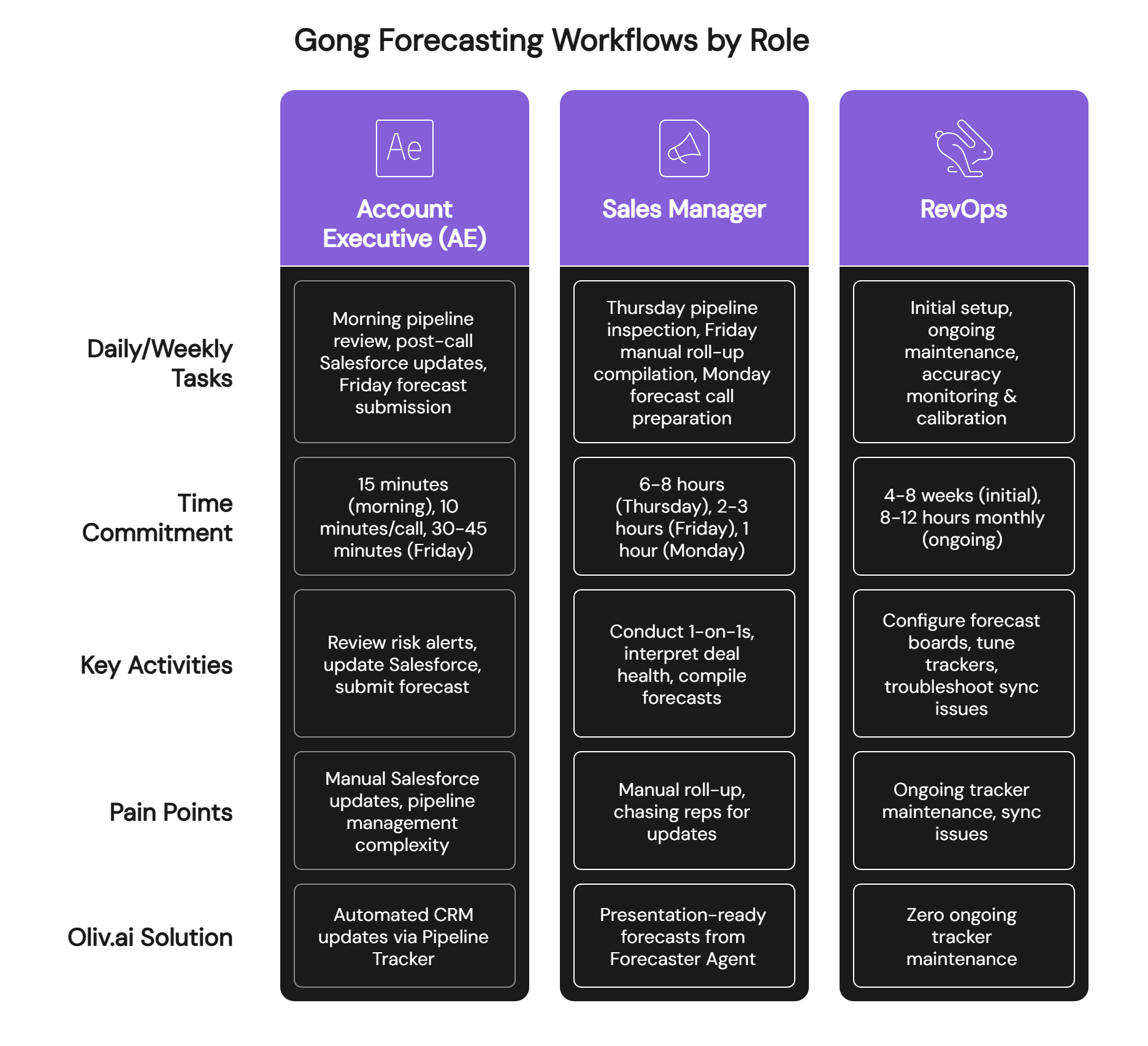
📱 Account Executive (AE) Daily Workflow
Morning Pipeline Review (15 minutes):
- Log into Gong dashboard to review deals flagged with risk alerts
- Check conversation insights from yesterday's calls for new objections or competitor mentions
- Identify which deals require forecast category updates based on latest developments
Post-Call Activities (10 minutes per call):
- Manually update Salesforce forecast categories (Commit/Best Case/Pipeline) within 24 hours of significant developments
- Add activity notes justifying category changes for manager visibility
- Review Gong's deal health score but note it requires human interpretation—no automated recommendations
Friday Forecast Submission (30-45 minutes):
- Review entire pipeline before forecast lock deadline
- Update close dates for deals that shifted timing
- Ensure CRM hygiene (amounts, stages, next steps populated)
- Submit final forecast category confirmations to manager
John S., Senior Account Executive, describes complexity:
"Understanding the pipeline management portion of it is almost impossible. Some people figure it out, but I think most just fumble through."
— John S., Senior Account Executive G2 Verified Review
👔 Sales Manager Weekly Forecast Review Process
Thursday Pipeline Inspection (6-8 hours):
- Conduct 1-on-1 pipeline reviews with each rep (1-2 hours per rep for 5-person team)
- Manually review Gong dashboards to interpret deal health signals across team's opportunities
- Identify at-risk deals requiring coaching interventions
- Chase reps for overdue CRM updates affecting forecast accuracy
Friday Manual Roll-Up Compilation (2-3 hours):
- Aggregate individual rep forecasts manually (Gong lacks automatic roll-up functionality)
- Build consolidated forecast spreadsheet calculating team totals
- Prepare presentation slides for VP review with deal-by-deal justifications
- Review historical accuracy trends to calibrate current quarter predictions
Scott T., Director of Sales, notes adoption success but cost frustration:
"Gong has become the single source of truth for our sales team. From deal management to forecasting it's been really easy to gain adoption... The additional products like forecast or engage come at an additional cost."
— Scott T., Director of Sales G2 Verified Review
Monday Forecast Call Preparation (1 hour):
- Finalize presentation deck with forecast numbers, pipeline coverage analysis, and risk assessments
- Prepare answers for executive questions about specific deals
- Document assumptions underlying forecast commitments
Understanding how revenue orchestration platforms work reveals how modern systems automate the manager roll-up process Gong still requires manually.
⚙️ RevOps Configuration & Maintenance Responsibilities
Initial Setup (4-8 weeks):
- Configure forecast boards matching organizational hierarchy (Region → Team → Rep)
- Map CRM fields to Gong forecast categories and custom fields (maximum 25 custom fields)
- Set up multi-currency conversion if operating globally (irreversible configuration)
- Create territory mappings and manager-rep reporting relationships
Ongoing Maintenance (8-12 hours monthly):
- Tune trackers as sales messaging evolves (15-30% accuracy degradation quarterly without maintenance)
- Monitor forecast accuracy metrics identifying systematic biases by rep/region
- Troubleshoot sync issues between Gong and CRM (5-10 minute delays)
- Update field mappings when sales methodologies change (MEDDIC/BANT framework adjustments)
Alexis F., Sr Director of Revenue Operations & Enablement, appreciates support but notes feature gaps:
"I love the UI, the date I can pull, and more importantly the level of support I receive from their team... Small feature requests but nothing significant."
— Alexis F., Sr Director of Revenue Operations & Enablement G2 Verified Review
Accuracy Monitoring & Calibration:
- Weekly forecast accuracy analysis (predicted vs. actual results)
- Monthly calibration sessions addressing rep-specific over/under-forecasting patterns
- Quarterly reviews of forecast category conversion rates
Detailed Gong implementation timeline analysis reveals the true RevOps burden extending far beyond initial setup through ongoing maintenance requirements.
How Oliv.ai Simplifies Role-Based Workflows
We eliminate manual processes across all personas. AEs receive automated CRM updates via Pipeline Tracker's nightly hands-free calls. Managers get presentation-ready weekly forecasts from Forecaster Agent without 6-hour Friday compilation marathons. RevOps benefits from zero ongoing tracker maintenance—generative AI adapts automatically without quarterly tuning.
Q10. Advanced Gong Forecasting: Multi-Currency, Global Teams & Sales Methodologies [toc=Advanced Implementation]
Enterprise forecasting complexity multiplies across international operations. Multi-currency handling, global team coordination, and sales methodology integration require advanced configuration beyond basic Gong Forecast setup.
💱 Multi-Currency Forecasting Setup
Salesforce Conversion Rate Configuration:
Enable multi-currency in Gong via Admin center > Settings > CRM > Salesforce and select "We use multiple currencies". Gong derives available currencies and conversion rates from Salesforce's conversion rate table—when Salesforce rates change, deal values update automatically in Gong.
⚠️ Critical Implementation Warnings:
- Multi-currency activation converts all deal values into default company currency including historical closed deals—this action cannot be reversed
- If using custom amount fields for converted values, ensure Salesforce amount field uses original (not converted) amounts to prevent double-conversion errors
- Dynamic dated exchange rates reflect in Gong when enabled in Salesforce
Regional Currency Selection:
By default, deals convert to corporate currency. Individual users can select preferred viewing currency from currency selector to view pipeline, targets, and forecast numbers in regional currency. Submitted forecasts convert automatically between personal currency and corporate currency.
Known Limitation: Users report currency conversion inconsistencies in forecast roll-ups. One user notes: "Multiple currency issue with Gong Forecast—trying to help find workarounds."
🌍 Cross-Regional Team Coordination
Territory Mapping & Hierarchies:
- Configure territory-based access controls matching geographical sales structure
- Map manager-rep relationships across regions for coaching workflows
- Set up forecast submission deadlines accounting for time zone differences (EMEA Friday = Thursday night US Pacific)
Manager Roll-Up Challenges:
Global managers manually aggregate forecasts across distributed teams spanning multiple currencies and time zones. This requires coordinating Friday deadline compliance across regions where "Friday" occurs at different times—APAC submits 12-16 hours before Americas.
Exploring best revenue orchestration platforms reveals how modern systems handle global coordination automatically through unified architectures.
📋 Sales Methodology Integration
MEDDIC Framework Custom Field Mapping:
Configure custom Salesforce fields capturing MEDDIC components:
- Metrics: Quantifiable business value (ROI, cost savings)
- Economic Buyer: Budget authority identification
- Decision Criteria: Evaluation framework
- Decision Process: Timeline and approval workflow
- Identify Pain: Core business problem
- Champion: Internal advocate driving deal
Map these fields to Gong for conversation-based auto-population. However, Gong's keyword-based approach often misses nuanced MEDDIC signals requiring manual verification.
Karel Bos, Head of Sales, confirms underutilization:
"There's so much in Gong, that we don't use everything. Gongs deal forecasting we don't use."
— Karel Bos, Head of Sales TrustRadius Verified Review
BANT Qualification Framework:
Similar custom field mapping for BANT criteria:
- Budget: Financial capacity confirmed
- Authority: Decision-maker identified
- Need: Business problem validated
- Timeline: Purchase timeframe established
Forecast Board Templates by Methodology:
Create methodology-specific forecast boards with custom columns displaying qualification scores. For MEDDIC-driven organizations, boards show Economic Buyer identification status, Champion engagement level, and Decision Criteria alignment—enabling managers to assess forecast risk based on methodology completeness.
Complexity Considerations:
BANT: Simpler framework suitable for SMB sales (4 qualification criteria)
MEDDIC: Complex enterprise framework requiring detailed tracking (6+ components)
Trafford J., Senior Director Revenue Enablement, highlights setup challenges:
"It can be overwhelming to set up trackers. AI training is a bit laborious to get it to do what you want."
— Trafford J., Senior Director of Revenue Enablement G2 Verified Review
Understanding Gong's overall feature set provides context for how forecasting fits within the broader platform capabilities and limitations.
How Oliv.ai Handles Advanced Scenarios
We built native support for multi-currency forecasting with automatic conversion handling. Global teams benefit from unified time-zone-aware workflows. Sales methodology integration is seamless—our AI auto-populates MEDDIC/BANT scorecards from conversation analysis without manual field mapping or ongoing tracker maintenance.
Q11. What is AI-Native Forecasting? (The Autonomous Alternative) [toc=AI-Native Forecasting]
Pre-2023 revenue intelligence platforms—Gong, Clari, Salesloft—were built on keyword matching and activity tracking: counting competitor mentions, measuring talk time, flagging specific phrases. Post-generative AI era (2023+) enables contextual understanding of conversations (intent, sentiment, nuance), predictive analytics continuously updating in real-time, and autonomous agents executing workflows without human intervention. This represents fundamental architectural shift—like the difference between calculator and computer.
❌ Old vs. New Forecasting Approaches
Traditional (Gong/Clari) Workflow:
- Manual data entry by reps updating CRM fields
- Static dashboard analysis requiring manager login and interpretation
- Human interpretation required to understand red/yellow/green flags
- Manual action planning based on insights
- Periodic forecast updates (weekly/biweekly manual roll-ups)
AI-Native (Oliv.ai) Workflow:
- Automatic data capture across all channels (calls + emails + CRM + meetings)
- Continuous contextual analysis in background without human prompting
- AI prescribes specific actions with supporting reasoning
- Autonomous execution—agents act without human triggers
- Real-time forecast updates with predictive commentary explaining changes
Annabelle H., Board Director, captures AI maturity gap in traditional tools:
"AI is not great (yet)—the product still feels like its at its infancy and needs to be developed further."
— Annabelle H., Board Director G2 Verified Review
Comparing Gong vs Oliv directly reveals the architectural differences between pre-generative AI platforms and modern AI-native systems.
🤖 The Agentic Workflow Revolution
Instead of SaaS applications requiring human adoption, training, and ongoing operation, AI agents perform jobs on behalf of users autonomously:
- Forecaster Agent: Autonomously generates weekly forecasts with AI commentary explaining predictions, risks, and required actions
- Pipeline Tracker: Conducts nightly hands-free rep updates via phone, eliminating manual CRM data entry burden
- Deal Driver: Flags risks and prescribes interventions ("Schedule technical deep-dive with IT team by Thursday") rather than generic alerts
- Analyst Agent: Answers strategic questions in plain English ("Which Q4 deals are at risk due to budget concerns?") with instant AI-generated analysis
This is "make SaaS the dirty word"—eliminate manual software operation entirely, shifting from tools humans use to agents that work for humans.
The evolution from revenue operations to intelligence to orchestration charts this fundamental transformation in how sales technology operates.
✨ Oliv.ai's AI-Native Architecture
1. AI Data Platform: Automatically captures all sales interactions (calls, emails, meetings, CRM changes) without manual entry, creating unified revenue dataset that powers all agents.
2. Generative AI Models: Extract deep insights (MEDDIC scorecards, deal qualification, buyer journey tracking) understanding context not just keywords. Recognizes that "budget freeze," "spending authority delayed," and "board approval needed" all signal the same risk despite different phrasing.
3. 30+ Customizable AI Agents: Execute specific jobs (forecasting, CRM updates, meeting prep, follow-ups) tailored to each role's workflow. Modular pricing allows teams to pay only for needed agents.
4. Proactive Intelligence Delivery: Insights arrive when/where needed (Slack/email 30 min before calls) vs. requiring dashboard logins and manual interpretation. Eliminates the "insights sitting unused in dashboards" problem plaguing traditional SaaS.
Elspeth C., Chief Commercial Officer, describes Gong dependency:
"Gong's product is second to none and without it, I couldn't do my job properly—it's my most visited tab on Chrome!"
— Elspeth C., Chief Commercial Officer G2 Verified Review
This illustrates how traditional SaaS demands constant human attention versus AI agents working autonomously.
📊 Autonomous Forecasting Outcomes
60% of businesses implementing AI forecasting report improved accuracy as of 2025 industry surveys. Oliv.ai customers specifically achieve:
- ⭐ 25% higher forecast accuracy than legacy platforms (pre/post migration comparisons)
- ⏰ 75% reduction in forecasting time (from 6 hours to 90 minutes weekly)
- ✅ 30% faster deal cycles (autonomous execution vs. manual workflows)
These outcomes prove AI-native autonomous approaches outperform manual SaaS workflows across all critical metrics—accuracy, efficiency, and velocity.
Q12. Should You Use Gong Forecast or Switch to AI-Native Platforms? [toc=Decision Framework]
Gong maintains legitimate strengths: market-leading conversation intelligence with established brand trust (8/10 rating for CI vs. 4/10 for forecasting), robust call recording/transcription (85-90% accuracy), valuable sales coaching capabilities with talk-time analytics, and strong CRM integrations developed over 8+ years. For teams solely focused on conversation analysis without forecasting needs, Gong remains viable—though expensive at $160-250/user/month requiring 6-month implementations.
Amanda R., Director Customer Success, values conversation AI:
"I love conversational AI. My favorite aspect of Gong is being able to go into any account and ask what is going on."
— Amanda R., Director Customer Success G2 Verified Review
⚠️ When Gong Forecasting Fails
1. High-Velocity Sales Teams: 50+ active deals overwhelm manual dashboard monitoring requiring constant human interpretation. Fast-moving deals shift direction but insights arrive 5-10 minutes late.
2. Dual-Tool Stack Costs: Companies already paying ~$500/user/month for Gong + Clari ($300K annually for 50-rep team) seeking cost consolidation and unified workflows.
3. Manual Forecasting Burden: Sales managers spending 6+ hours weekly on manual forecast compilation frustrated by administrative overhead rather than strategic coaching.
4. Real-Time Intervention Needs: Teams requiring immediate deal risk alerts vs. periodic reviews. Processing delays prevent timely intervention when deals deteriorate.
5. Poor CRM Hygiene Organizations: Manual data entry creates accuracy gaps Gong can't overcome—predictions depend entirely on complete, current CRM data.
Iris P., Head of Marketing/Sales/Partnerships, regrets cost commitment:
"It was a big mistake on our part to commit to a two year term. Gong is a really powerful tool but it's probably the highest end option on the market."
— Iris P., Head of Marketing/Sales/Partnerships G2 Verified Review
Exploring comprehensive Gong reviews provides additional user perspectives on when the platform meets needs versus when limitations create frustration.
✅ The Unified Platform Value Proposition
Modern revenue teams don't need separate tools for conversation intelligence, forecasting, CRM automation, and analytics. Separate systems create:
- Integration friction with 5-10 minute data sync delays
- Data silos requiring manual consolidation across platforms
- Duplicate costs ($300-500K annually for combined stacks)
- Manual consolidation work aggregating insights from multiple dashboards
AI-native platforms unify all revenue intelligence in single system. The question isn't "which tool for which job" but "which unified platform handles all revenue intelligence jobs autonomously with highest accuracy and lowest operational burden."
Understanding best Clari alternatives alongside evaluating Gong helps teams identify unified platforms replacing dual-tool stacks entirely.
🚀 Oliv.ai Migration Advantages
1. Unified Solution: Replaces Gong + Clari at 60-70% cost reduction ($180-210K annual savings for 50-rep team previously spending $300K).
2. Rapid Deployment: 1-2 week implementation vs. 6-month Gong timelines—ROI starts immediately.
3. Modular Agent Selection: Pay only for needed capabilities (Forecaster, Deal Driver, Meeting Assistant). No forced bundling.
4. Autonomous Forecasting: Eliminates 6-hour weekly manual prep entirely, converting to 15-minute reviews.
5. Future-Proof Investment: Generative AI foundation vs. pre-AI legacy platforms requiring eventual replacement.
Migration Path: Start with high-impact agents → Run parallel validation (2-4 weeks) → Expand to full platform → Sunset legacy tools once confidence established.
Comparing Gong alternatives comprehensively helps teams evaluate whether migration makes strategic sense for their specific use case and organizational maturity.
📋 Migration Considerations & Resources
Data Export: Conversation transcripts, CRM field mappings, historical forecast data from Gong
Overlap Period: 2-4 weeks running both platforms during validation recommended
Change Management: Agentic workflow adoption training for teams
ROI Framework: Track forecast accuracy improvement, time savings, cost reduction metrics
Downloadable Resources: Decision framework matrix (scoring your scenarios), pre-implementation checklist (data requirements, integration prerequisites), migration planning template (week-by-week transition plan).
Early adopters consistently achieve positive ROI within first quarter, validating migration decisions with measurable outcomes: 25% higher accuracy, 30% faster deal velocity, 60-70% cost reduction.
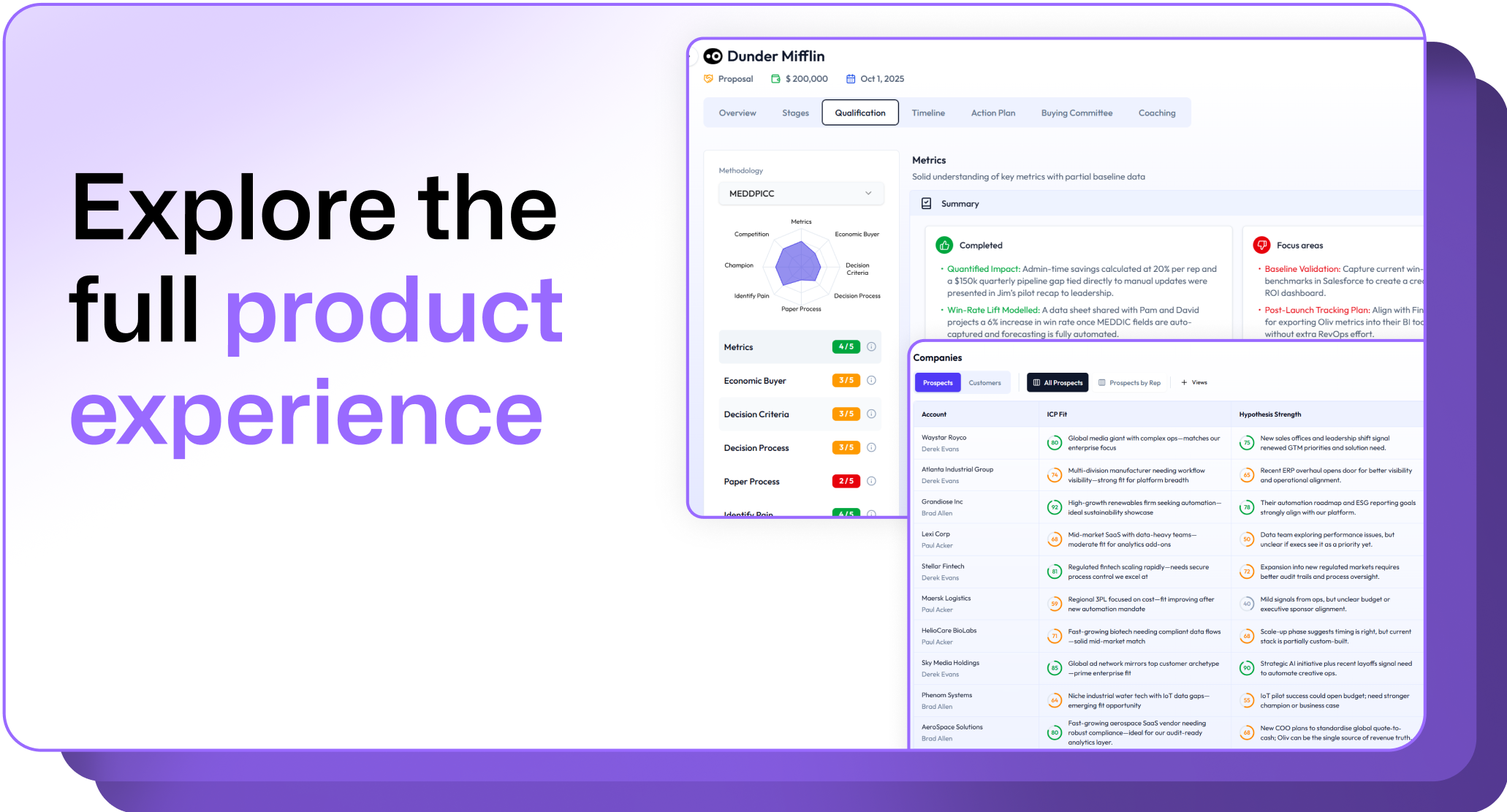
.png)
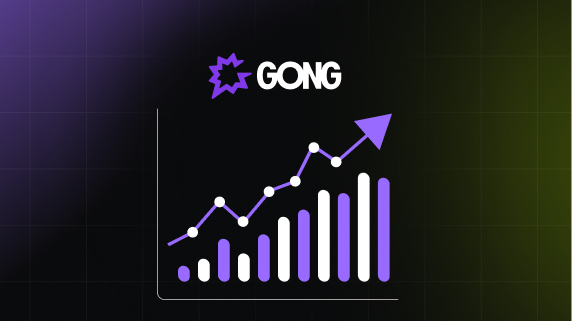


.png)
